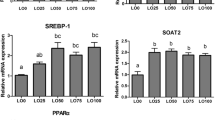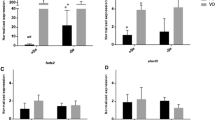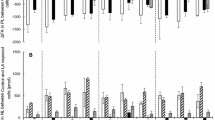Abstract
The present study was conducted to evaluate the effects on Atlantic salmon hepatic lipid metabolism when fed diets with increasing substitution of fish oil (FO) with a vegetable oil (VO) blend. Four diets with VOs replacing 100, 90, 79 and 65 % of the FO were fed for 5 months. The levels of eicosapentaenoic acid (EPA; 20:5n-3) and docosahexaenoic acid (DHA; 22:6n-3) in the experimental diets ranged from 1.3 to 7.4 % of fatty acids (FAs), while cholesterol levels ranged from 0.6 to 1.2 g kg−1. In hepatocytes added [1-14C] α-linolenic acid (ALA, 18:3n-3), more ALA was desaturated and elongated to EPA and DHA in cells from fish fed 100 % VO, while in fish fed 65 % VO, ALA was elongated to eicosatrienoic acid (ETE; 20:3n-3), indicating reduced Δ6 desaturation activity. Despite increased desaturation activity and activation of the transcription factor Sp1 in fish fed 100 % VO, liver phospholipids contained less EPA and DHA compared with the 65 % VO group. The cholesterol levels in the liver of the 100 % VO group exceeded the levels in fish fed the 65 % VO diet, showing an inverse relationship between cholesterol intake and liver cholesterol content. For the phytosterols, levels in liver were generally low. The area as a proxy of volume of lipid droplets was significantly higher in salmon fed 100 % VO compared with salmon fed 65 % VO. In conclusion, the current study suggests that suboptimal dietary levels of cholesterol in combination with low levels of EPA and DHA (1.3 % of FAs) can result in minor metabolic perturbations in the liver of Atlantic salmon.





Similar content being viewed by others
References
Alvheim AR et al (2013) Dietary linoleic acid elevates endogenous 2-arachidonoylglycerol and anandamide in Atlantic salmon (Salmo salar L.) and mice, and induces weight gain and inflammation in mice. Br J Nutr 109:1508–1517
Bell JG, McEvoy J, Tocher DR, McGhee F, Campbell PJ, Sargent JR (2001) Replacement of fish oil with rapeseed oil in diets of Atlantic salmon (Salmo salar) affects tissue lipid compositions and hepatocyte fatty acid metabolism. J Nutr 131:1535–1543
Bell JG et al (2002) Substituting fish oil with crude palm oil in the diet of Atlantic salmon (Salmo salar) affects muscle fatty acid composition and hepatic fatty acid metabolism. J Nutr 132:222–230
Bennett MK, Osborne TF (2000) Nutrient regulation of gene expression by the sterol regulatory element binding proteins: increased recruitment of gene-specific coregulatory factors and selective hyperacetylation of histone H3 in vivo. Proc Natl Acad Sci USA 97:6340–6344
Bernacer R, Roig D, Lozano B (2015) Plant sterols for adults with hypercholesterolemia treated with or without medication (statins). Rev Esp Nutr Hum Diet 19:105–115
Brown MS, Goldstein JL (1997) The SREBP pathway: regulation of cholesterol metabolism by proteolysis of a membrane-bound transcription factor. Cell 89:331–340
Carmona-Antonanzas G, Tocher DR, Martinez-Rubio L, Leaver MJ (2014) Conservation of lipid metabolic gene transcriptional regulatory networks in fish and mammals. Gene 534:1–9
Courey AJ, Tjian R (1988) Analysis of Sp1 in vivo reveals multiple transcriptional domains, including a novel glutamine-rich activation motif. Cell 55:887–898
Du S (2014) Lipid metabolism in Atlantic salmon (Salmo salar L.) fed low dietary levels of the marine n-3 fatty acids EPA and DHA. Master in Nutrition of Aquatic Organisms in Aquaculture. Department of Biology, University of Bergen, National Institute of Nutrition and Seafood Research, pp 80
Ducheix S, Montagner A, Theodorou V, Ferrier L, Guillou H (2013) The liver X receptor: a master regulator of the gut-liver axis and a target for non alcoholic fatty liver disease. Biochem Pharmacol 86:96–105
Espe M, Rathore RM, Du ZY, Liaset B, El-Mowafi A (2010) Methionine limitation results in increased hepatic FAS activity, higher liver 18:1 to 18:0 fatty acid ratio and hepatic TAG accumulation in Atlantic salmon, Salmo salar. Amino Acids 39:449–460
Folch J, Lees M, Stanley GHS (1957) A simple method for the isolation and purification of total lipids from animal tissues. J Biol Chem 226:497–509
Froyland L, Vaagenes H, Asiedu DK, Garras A, Lie O, Berge RK (1996) Chronic administration of eicosapentaenoic acid and docosahexaenoic acid as ethyl esters reduced plasma cholesterol and changed the fatty acid composition in rat blood and organs. Lipids 31:169–178
Grundy SM, Mok HYI (1977) Determination of cholesterol absorption in man by intestinal perfusion. J Lipid Res 18:263–271
Hagen G, Dennig J, Preiss A, Beato M, Suske G (1995) Functional analyses of the transcription factor sp4 reveal properties distinct from Sp1 and Sp3. J Biol Chem 270:24989–24994
Henderson RJ, Park MT, Sargent JR (1995) The desaturation and elongation of C-14-labeled polyunsaturated fatty acids by pike (Esox lucius L.) in vivo. Fish Physiol Biochem 14:223–235
Horton JD, Goldstein JL, Brown MS (2002) SREBPs: activators of the complete program of cholesterol and fatty acid synthesis in the liver. J Clin Invest 109:1125–1131
Hoshi M, Williams M, Kishimot Y (1973) Esterification of fatty acids at room temperature by chloroform-methanolic HCl cupric acetate. J Lipid Res 14:599–601
Ikonen E (2008) Cellular cholesterol trafficking and compartmentalization. Nat Rev Mol Cell Biol 9:125–138
Jordal AEO, Lie O, Torstensen BE (2007) Complete replacement of dietary fish oil with a vegetable oil blend affect liver lipid and plasma lipoprotein levels in Atlantic salmon (Salmo salar L.). Aquac Nutr 13:114–130
Kjaer MA, Vegusdal A, Gjoen T, Rustan AC, Todorevic M, Ruyter B (2008) Effect of rapeseed oil and dietary n-3 fatty acids on triacylglycerol synthesis and secretion in Atlantic salmon hepatocytes. BBA Mol Cell Biol Lipids 1781:112–122
Kortner TM, Bjorkhem I, Krasnov A, Timmerhaus G, Krogdahl A (2014) Dietary cholesterol supplementation to a plant-based diet suppresses the complete pathway of cholesterol synthesis and induces bile acid production in Atlantic salmon (Salmo salar L.). Br J Nutr 111:2089–2103
Laakso P (2005) Analysis of sterols from various food matrices. Eur J Lipid Sci Tech 107:402–410
Leaver MJ, Villeneuve LAN, Obach A, Jensen L, Bron JE, Tocher DR, Taggart JB (2008) Functional genomics reveals increases in cholesterol biosynthetic genes and highly unsaturated fatty acid biosynthesis after dietary substitution of fish oil with vegetable oils in Atlantic salmon (Salmo salar). Bmc Genomics 9:1
Lie O, Lambertsen G (1991) Fatty acid composition of glycerophospholipids in 7 tissues of cod (gadus-morhua), determined by combined high-performance liquid-chromatography and gas-chromatography. J Chromatogr Biomed Appl 565:119–129
Liland NS (2014) Atlantic salmon (Salmo salar L.) sterol metabolism and metabolic health impact of dietary lipids. PhD thesis. Department of Biology, University of Bergen, National Institute of Nutrition and Seafood Research, pp 300
Liland NS et al (2013) High levels of dietary phytosterols affect lipid metabolism and increase liver and plasma TAG in Atlantic salmon (Salmo salar L.). Br J Nutr 110:1958–1967
Madsen L, Rustan AC, Vaagenes H, Berge K, Dyroy E, Berge RK (1999) Eicosapentaenoic and docosahexaenoic acid affect mitochondrial and peroxisomal fatty acid oxidation in relation to substrate preference. Lipids 34:951–963
Mason ME, Waller GR (1964) Dimethoxypropane induced transesterification of fats + oils in preparation of methyl esters for gas chromatographic analysis. Anal Chem 36:583
Miller MR, Nichols PD, Carter CG (2008) The digestibility and accumulation of dietary phytosterols in Atlantic salmon (Salmo salar L.) smolt fed diets with replacement plant oils. Lipids 43:549–557
Minghetti M, Leaver MJ, Tocher DR (2011) Transcriptional control mechanisms of genes of lipid and fatty acid metabolism in the Atlantic salmon (Salmo salar L.) established cell line, SHK-1. BBA Mol Cell Biol Lipids 1811:194–202
Monroig O, Li YY, Tocher DR (2011) Delta-8 desaturation activity varies among fatty acyl desaturases of teleost fish: high activity in delta-6 desaturases of marine species. Comp Biochem Physiol B Biochem Mol Biol 159:206–213
Narce M, Gresti J, Bezard J (1988) Method for evaluating the bioconversion of radioactive poly-unsaturated fatty-acids by use of reversed-phase liquid-chromatography. J Chromatogr 448:249–264
Nossen JO, Rustan AC, Gloppestad SH, Malbakken S, Drevon CA (1986) Eicosapentaenoic acid inhibits synthesis and secretion of triacylglycerols by cultured rat hepatocytes. BBA 879:56–65
Penno A, Hackenbroich G, Thiele C (2013) Phospholipids and lipid droplets. BBA Mol Cell Biol Lipids 1831:589–594
Phillips KM, Ruggio DM, Toivo JI, Swank MA, Simpkins AH (2002) Free and esterified sterol composition of edible oils and fats. J Food Compos Anal 15:123–142
Rosenlund G, Torstensen B, Stubhaug I, Usman N, Sissener NH (2016) Atlantic salmon require long-chain n-3 fatty acids for optimal growth throughout the seawater period. J Nutr Sci (in press)
Ruohonen K (1998) Individual measurements and nested designs in aquaculture experiments: a simulation study. Aquaculture 165:149–157
Rustan AC, Nossen JO, Christiansen EN, Drevon CA (1988) Eicosapentaenoic acid reduces hepatic synthesis and secretion of triacylglycerol by decreasing the activity of acyl-coenzyme a—1,2-diacylglycerol acyltransferase. J Lipid Res 29:1417–1426
Ruyter B, Thomassen MS (1999) Metabolism of n-3 and n-6 fatty acids in Atlantic salmon liver: stimulation by essential fatty acid deficiency. Lipids 34:1167–1176
Ruyter B, Rosjo C, Einen O, Thomassen MS (2000a) Essential fatty acids in Atlantic salmon: time course of changes in fatty acid composition of liver, blood and carcass induced by a diet deficient in n-3 and n-6 fatty acids. Aquac Nutr 6:109–117
Ruyter B, Rosjo C, Masoval K, Einen O, Thomassen MS (2000b) Influence of dietary n-3 fatty acids on the desaturation and elongation of 1-C-14 18: 2 n-6 and 1-C-14 18: 3 n-3 in Atlantic salmon hepatocytes. Fish Physiol Biochem 23:151–158
Ruyter B, Moya-Falcon C, Rosenlund G, Vegusdal A (2006) Fat content and morphology of liver and intestine of Atlantic salmon (Salmo salar): effects of temperature and dietary soybean oil. Aquaculture 252:441–452
Sanden M, Stubhaug I, Berntssen MHG, Lie O, Torstensen BE (2011) Atlantic salmon (Salmo salar L.) as a net producer of long-chain marine omega-3 fatty acids. J Agric Food Chem 59:12697–12706
Shepherd CJ, Jackson AJ (2013) Global fishmeal and fish-oil supply: inputs, outputs and markets. J Fish Biol 83:1046–1066
Sissener NH, Torstensen B, Liland NS, Rosenlund G (2016) Temperature modulates liver lipid accumulation in Atlantic salmon (Salmo salar L.) fed low dietary levels of n-3 long- chain fatty acids. Aquacu Nutr (accepted)
Stubhaug I, Tocher DR, Bell JG, Dick JR, Torstensen BE (2005) Fatty acid metabolism in Atlantic salmon (Salmo salar L.) hepatocytes and influence of dietary vegetable oil. BBA Mol Cell Biol Lipids 1734:277–288
Stubhaug I, Lie O, Torstensen BE (2007) Fatty acid productive value and beta-oxidation capacity in Atlantic salmon (Salmo salar L.) fed on different lipid sources along the whole growth period. Aquac Nutr 13:145–155
Thomassen MS, Rein D, Berge GM, Ostbye TK, Ruyter B (2012) High dietary EPA does not inhibit Delta 5 and Delta 6 desaturase in Atlantic salmon (Salmo salar L.) fed rapeseed oil diets. Aquaculture 360:78–85
Tocher DR, Bell JG, Dick JR, Sargent JR (1997) Fatty acyl desaturation in isolated hepatocytes from Atlantic salmon (Salmo salar): stimulation by dietary borage oil containing gamma-linolenic acid. Lipids 32:1237–1247
Tocher DR, Fonseca-Madrigal J, Bell JG, Dick JR, Henderson RJ, Sargent JR (2002) Effects of diets containing linseed oil on fatty acid desaturation and oxidation in hepatocytes and intestinal enterocytes in Atlantic salmon (Salmo salar). Fish Physiol Biochem 26:157–170
Torstensen BE, Lie O, Froyland L (2000) Lipid metabolism and tissue composition in Atlantic salmon (Salmo salar L.)—Effects of capelin oil, palm oil, and oleic acid-enriched sunflower oil as dietary lipid sources. Lipids 35:653–664
Torstensen BE, Froyland L, Ornsrud R, Lie O (2004) Tailoring of a cardioprotective muscle fatty acid composition of Atlantic salmon (Salmo salar) fed vegetable oils. Food Chem 87:567–580
Torstensen BE, Espe M, Stubhaug I, Lie O (2011) Dietary plant proteins and vegetable oil blends increase adiposity and plasma lipids in Atlantic salmon (Salmo salar L.). Br J Nutr 3:1–15
Vandesompele J, De Preter K, Pattyn F, Poppe B, Van Roy N, De Paepe A, Speleman F (2002) Accurate normalization of real-time quantitative RT-PCR data by geometric averaging of multiple internal control genes. Genome Biol 3:research0034.0031–research0034.0011
Vegusdal A, Gjoen T, Berge RK, Thomassen MS, Ruyter B (2005) Effect of 18:1n-9, 20:5n-3, and 22:6n-3 on lipid accumulation and secretion by Atlantic salmon hepatocytes. Lipids 40:477–486
Ytrestøyl T, Aas TS, Åsgård T (2014) Resource utilisation of Norwegian salmon farming in 2012 and 2013, vol 36. Nofima report
Zheng X, Leaver MJ, Tocher DR (2009) Long-chain polyunsaturated fatty acid synthesis in fish: comparative analysis of Atlantic salmon (Salmo salar L.) and Atlantic cod (Gadus morhua L.) Δ6 fatty acyl desaturase gene promoters. Comp Biochem Physiol B Biochem Mol Biol 154:255–263
Acknowledgments
This study was financed by Regionalt Forskningsfond Vest (#217478) and Research Council of Norway (#225086/E40) as well as Skretting ARC. Technical staff at NIFES and Skretting ARC are thanked for excellent assistance with the feeding trial and the chemical analysis.
Author information
Authors and Affiliations
Corresponding author
Electronic supplementary material
Below is the link to the electronic supplementary material.
Rights and permissions
About this article
Cite this article
Sanden, M., Liland, N.S., Sæle, Ø. et al. Minor lipid metabolic perturbations in the liver of Atlantic salmon (Salmo salar L.) caused by suboptimal dietary content of nutrients from fish oil. Fish Physiol Biochem 42, 1463–1480 (2016). https://doi.org/10.1007/s10695-016-0233-3
Received:
Accepted:
Published:
Issue Date:
DOI: https://doi.org/10.1007/s10695-016-0233-3




